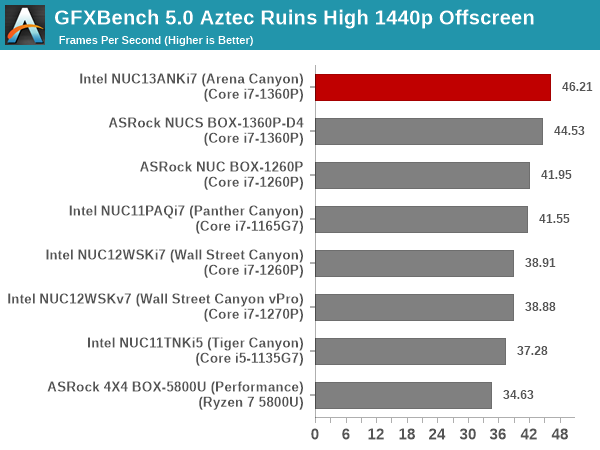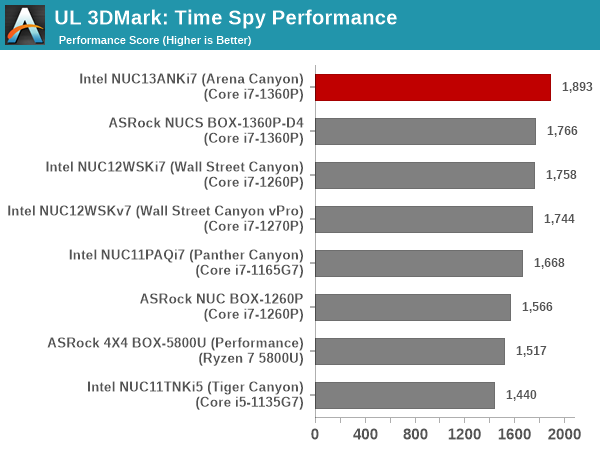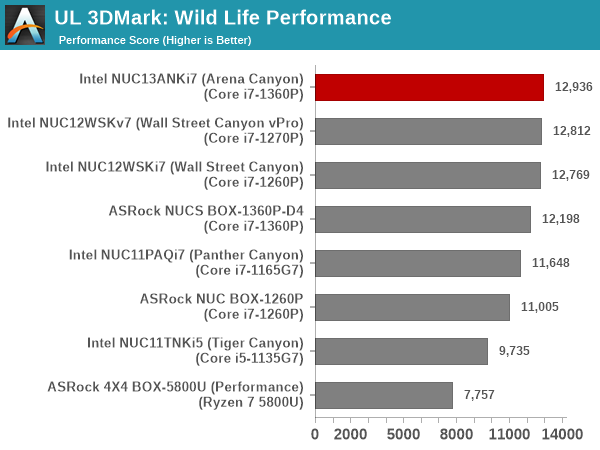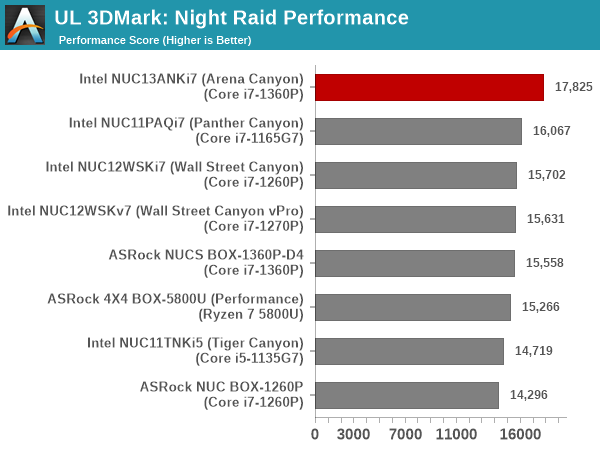Intel NUC 13 Pro Arena Canyon Review: Raptor Lake Brings Incremental Gains
by Ganesh T S on March 27, 2023 9:00 AM ESTGPU Performance: Synthetic Benchmarks
Intel did not make significant changes in the integrated GPU when moving from Alder Lake to Raptor Lake. Process maturity has allowed it to clock the iGPU a bit higher, but the number of EUs remains the same as in the previous generation. GPU performance evaluation typically involved gaming workloads, and for select PCs, GPU compute. Prior to that, we wanted to take a look at the capabilities of the iGPU in the Core i7-1360P. Unfortunately, GPU-Z doesn't yet recognize the 'new' GPU, but HWiNFO has more helpful information tallying with the claimed iGPU specifications.
We have seen earlier that the performance of the Intel Iris Xe Graphics is miles ahead of previous iGPUs from both Intel and AMD. The benchmarks processed on the NUC13ANKi7 back up that aspect.
GFXBench
The DirectX 12-based GFXBench tests from Kishonti are cross-platform, and available all the way down to smartphones. As such, they are not very taxing for discrete GPUs and modern integrated GPUs. We processed the offscreen versions of the 'Aztec Ruins' benchmark.


The 1.5 GHz clock and high EU count expectedly land the Arena Canyon NUC at the top of the file.
UL 3DMark
Four different workload sets were processed in 3DMark - Fire Strike, Time Spy, Night Raid, and Wild Life.
3DMark Fire Strike
The Fire Strike benchmark has three workloads. The base version is meant for high-performance gaming PCs. It uses DirectX 11 (feature level 11) to render frames at 1920 x 1080. The Extreme version targets 1440p gaming requirements, while the Ultra version targets 4K gaming system, and renders at 3840 x 2160. The graph below presents the overall score for the Fire Strike Extreme and Fire Strike Ultra benchmark across all the systems that are being compared.
| UL 3DMark - Fire Strike Workloads | |||

3DMark Time Spy
The Time Spy workload has two levels with different complexities. Both use DirectX 12 (feature level 11). However, the plain version targets high-performance gaming PCs with a 2560 x 1440 render resolution, while the Extreme version renders at 3840 x 2160 resolution. The graphs below present both numbers for all the systems that are being compared in this review.
| UL 3DMark - Time Spy Workloads | |||

3DMark Wild Life
The Wild Life workload was initially introduced as a cross-platform GPU benchmark in 2020. It renders at a 2560 x 1440 resolution using Vulkan 1.1 APIs on Windows. It is a relatively short-running test, reflective of mobile GPU usage. In mid-2021, UL released the Wild Life Extreme workload that was a more demanding version that renders at 3840 x 2160 and runs for a much longer duration reflective of typical desktop gaming usage.
| UL 3DMark - Wild Life Workloads | |||

3DMark Night Raid
The Night Raid workload is a DirectX 12 benchmark test. It is less demanding than Time Spy, and is optimized for integrated graphics. The graph below presents the overall score in this workload for different system configurations.

All of the above benchmarks see the NUC13ANKi7 emerge comfortably on top. Having the fastest iGPU clock and highest power budget mean that this is not a surprising result.











46 Comments
View All Comments
PeachNCream - Tuesday, March 28, 2023 - link
I congratulate you. Your bait caught a lot of them this time. And, like a true troll, you didn't waste keystrokes doing it. Though, admittedly, computer enthusiasts are low hanging fruit that get riled up with minimal work.MrCommunistGen - Monday, March 27, 2023 - link
I'm pretty pleased that there are P-series chips and not just U-series - as many (but not all) previous SFF NUCs used 15W TDP chips rather than 28W and higher TDP mobile CPUs. As long as the cooler can handle the heat load and isn't too terribly loud (or can have its performance/fan curves adjusted) then this could be a really cool SFF PC.I currently have a NUC8i7BEH i7-8559U (28W 4c/8t + eDRAM) which I'm not YET looking to upgrade, but this new 13th Gen NUC is the first model that's gotten me excited about a new NUC in this form factor.
Samus - Tuesday, March 28, 2023 - link
I agree. The P-series was a solid move on Intel's part to stay competitive against Ryzen mobile parts. Even though most notebooks don't seem to utilize the TDP Up (if its a thin plastic laptop kiss PL2 goodbye entirely) the single-threaded boost performance is above U-series parts, and general workflow at low-loads benefit from the stronger E-core headroom. Intel competitively prices the P chips against the U chips as well, which is why you see them in cheaper laptops.abufrejoval - Tuesday, March 28, 2023 - link
The latest U-series to me represent an attempt to have at least a toenail in a fully passive market and that's not an economy niche, even if Intel can put more of them on a wafer: sometimes Intel is strangely insensitive to wasting die area!And since NUCs have always used active cooling even for their Atom models, U-series SoCs simply have no business there.
I am also a fan of the great NUC fan curves, because they allow you to achieve unobtrusiveness, which is only beaten by "never need cleaning out fans and grills", but not at the price of crippled performance or an Akasa case.
I have the same NUC and it's younger cousins, a hexacore NUC10 and a Tiger Lake NUC11. And that last "custom Apple" SoC with the Iris 655 iGPU in the i7-8559U spends more than half its die area on an iGPU that Intel never charged for, but mostly because it didn't actually pay of in performance.
The Tiger Lake trounces NUC8 and 10 by 25% on scalar peformance while the 6 cores of Gen10 and 4 cores of Gen11 draw even on multicore.
The Tiger Lake's 96EU Xe iGPU puts the Iris 48EU iGPU to shame, which only gets 50% performance increase over an 24EU iGPU from the NUC10 for twice the EUs and without needing the eDRAM, which doesn't help nearly as much as it must have cost in production. It marks the turning point for Apple, which wanted much more GPU power at mobile power budgets.
Yes, you can expect a tempting performance uplift from one of these, should you make the switch. But a gaming engine it won't be, because 4x the speed of a lame duck is still pretty lame.
ekon - Monday, March 27, 2023 - link
I like the multitasking benchmarks; don't see that attempted very often as it's not an off-the-shelf test and involves the time and risk of coming up with your own methodology, but it's teased out some interesting results.cruiseliu - Monday, March 27, 2023 - link
Kinda surprised it's still DDR4.Samus - Tuesday, March 28, 2023 - link
I was surprised to see that too. Even 6 months ago I wouldn't be since DDR5 SODIMMs were still elusive unicorns but nowadays they are plentiful and price competitive with DDR4. I've seen 32GB 16x2 kits of Crucial DDR5 5200(?) SODIMMs from B&H for $100 shipped yet nothing mobile seems to take DDR5, and if it does, it's non-upgradable (looking at you XPS 13)Fenturi - Tuesday, March 28, 2023 - link
U690 6800hx based with swappable ddr5MrCommunistGen - Tuesday, March 28, 2023 - link
Me too. I was going to write a follow-up comment about that, but then got a bit derailed writing my anti-rant comment.I suspect that the re-use of DDR4 was a cost saving measure so that they could (mostly) re-use the memory traces, etc from previous NUC boards instead of having to rework that for DDR5.
DDR5 doesn't help all workloads, particularly at JEDEC speeds, but there's definitely some where it helps. Having that little bit of extra performance in this form factor would be appreciated.
Einy0 - Tuesday, March 28, 2023 - link
In response to all the Mac mini comments. I've wanted to dip my toe into the OSX pond for a while now. I do some moonlighting for a business that uses a lot of Macs, and I feel like more hands on time with a Mac would be useful. The ancient Macbook own gives me some exposure but a lot was changed since OSX 10.6.8 . I just can't bring myself to get a mini with only 8GB or RAM. My Macbook has 4GB and a decent SSD and it is SLOW! I imagine newer versions of OSX are more memory hungry, like everything else. I also WILL NOT pay $200 more for $25 worth of RAM. It is plain insulting! Shame on Apple...